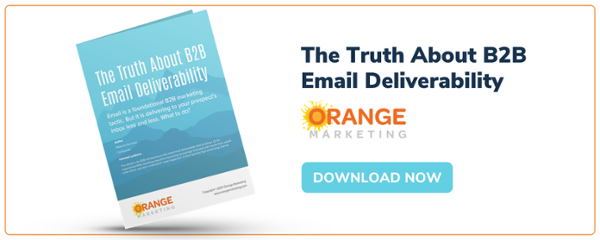Introduction
The real truth about B2B email deliverability is that emails deliver to your prospects’ inboxes less and less every month. Our goal is to give you the tools to stop this devastating trend.
Back in the 2000s, marketers could rent a list, send an email and get sales. Immediately. The formula was simple. When we start with any new B2B client, if the CMO is of a particular generation, we frequently have to arm wrestle them to resist their urge to upload all their lists and blanket email out of their sparkly new HubSpot account. If they ignore us and hit “send email” to 65,000 contacts anyway, HubSpot automatically turns off email capability pending further investigation. Why? Because the stats showed HubSpot instantly that the client was engaging in spam email tactics.
It is an embarrassing 😯 situation for us to be in as a HubSpot Partner. We then have to call our long-suffering Channel Consultant at HubSpot, beg for forgiveness, ask her to please plead our case to the HubSpot Messaging Team (“our client is new, they didn’t listen to us”), and give our poor client another chance.
What has happened to email? And how can a B2B company get its email delivered without angering the powers that be? Without making you acquire a Ph.D. in Email (cause we earned that degree, and it’s super dull at cocktail parties),we are going to provide you background on how email got so darn hard and the steps necessary to get your marketing email delivered straight to the inbox.
Is Email Still Relevant in B2B Marketing?
You bet your sweet 🍑 it is. Email is so worth it that it pays you to get it right. We lifted these B2B Email Marketing Stats out of an August-2021 HubSpot blog post (which they stole from others, and so on, and so goes the internet).
B2B Email Marketing Statistics
According to Litmus, Email generates $42 for every $1 spent, an incredible 4,200% ROI. Email is one of the cheapest and most effective ways to nurture your engaged prospects.
- 81% of B2B marketers say their most used form of content marketing is email newsletters. (Content Marketing Institute, 2020)
- 16% of all emails never make it into the inbox. (Email Tool Tester, 2019) THAT’S LOW IN OUR EXPERIENCE (yes, yelling in ALL CAPS)
- 87% of B2B marketers say email is one of their top free organic distribution channels. (Content Marketing Institute, 2020)
- 90% of content marketers say email engagement is the top metric they track to measure content performance. (Content Marketing Institute, 2020)
Email in B2B is not going away anytime soon.

Email Deliverability Glossary
You may know these definitions or find glossaries incredibly tedious (we get it, we’re detailed). If so, skip to 3. Email Deliverability Metrics.
As we go through the necessary information below, it helps us get on the same page. It's the boring bits for sure, but if you want to hang out with email geeks, you gotta speak the language. If you read through the below, it will help you understand why our best practices exist.
ESP - Email Service Provider
These are the software platforms that send email for you. The top five are:
- HubSpot
- MailChimp
- SendGrid
- Constant Contact
- Mail Gun
Why do you need a good ESP? An ESP ensures that your emails are sent from high-quality IP addresses, which helps avoid getting flagged by spam filters. Pure and simple, the first step to getting your emails delivered is by using a high-quality ESP. Pick from the top of the list vs. cheapest.
ISP - Internet Service Provider
An ISP (Internet Service Provider) is a company that provides individuals and companies access to the internet and other related services such as website building and hosting. An ISP feels it is their responsibility to prevent spam emails from getting through. Of the 270 billion emails that get sent every day, it is estimated that more than 50% are spam. A good ISP will ensure that spam does not make it to the spam folder, and you can forget about the inbox. Who are the big ISPs? Companies like:
- AT&T Wireless
- Verizon
- T-Mobile
- Spectrum
- Earthlink
- CenturyLink
And so on. There are currently 2,830 internet service providers in the United States alone. If they block your email, they feel they are the hero.
Email Services or Email Client or Inbox Providers
Apple iPhone or Apple Mail, Google Gmail, and Microsoft Outlook are the top three email services bar none in B2B. Nothing else counts. What role do these three gorillas play in email deliverability? They can become mega gatekeepers to spam, and each of these providers has its sophisticated techniques for labeling your email as garbage.
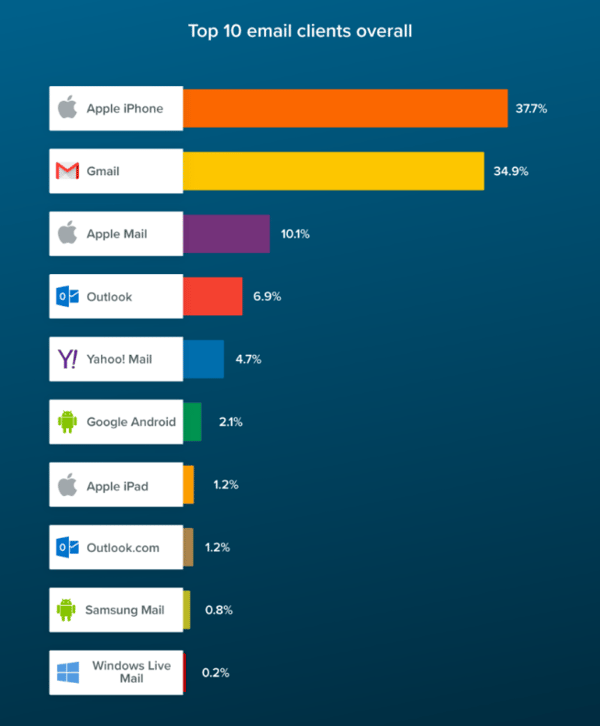
Email Client Litmus.com June 2021 Stats
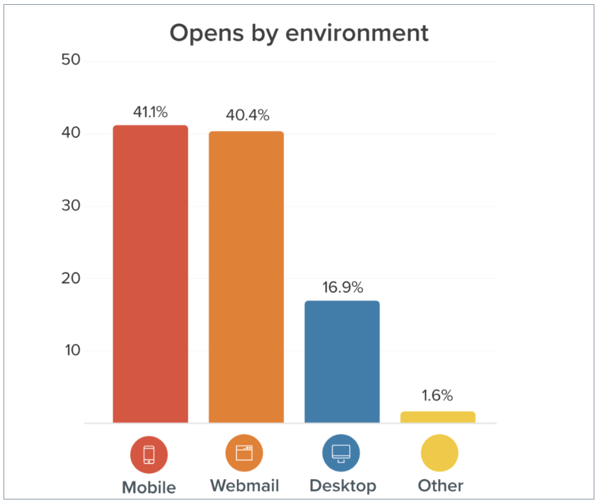
Email Opens by Environment Litmus.com June 2021 Stats
Graymail
Graymail is solicited bulk email messages that don't fit the definition of email spam (e.g., the recipient "opted into" receiving them). Recipient interest in this type of mailing tends to diminish over time, increasing the likelihood that recipients will report graymail as spam.
Over time your opt-in email list converts to graymail. And guess what? Apple, Google, and Microsoft know this and somehow are smart enough not to deliver emails they know your potential recipient won’t open. Awesome.
Sending Email IP Address
Email is sent from IP addresses, which serve as unique identifiers of email streams. Some companies send from a shared IP, which means multiple companies use the same IP address to send their email. When you use HubSpot or MailChimp to send your email, even though you provide your Sending Domain, the underlying sending email IP is theirs. If you do bad things, the ESP will shut you down to protect their IP Address and all the other companies that use it.
Sending Domain
Your email sending domain reputation is based on your sending domain instead of your IP address. ISPs are starting to use a combination of IP and domain reputation to identify spam. Your brand’s reputation is also part of the spam decision. And with domain reputation, you can’t change an IP address to fix spam deliverability problems.
Sending "From Email"
This is the email address your recipient will see in the inbox associated with your Marketing Email. Ours is hello@orangemarketing.com. The “Friendly From” is the sender’s name, such as “Marketing” or “Rebecca Gonzalez.”
Corporate Email Servers
Large companies run email servers, which come with arbitrary rules imposed by corporate messaging teams, who live to block your email. They are even sneaky enough to automatically tag your email as "open" before stopping it. When a corporate email server is involved, there is no guarantee that your email gets to the inbox, the promotions box, or even the spam folder. Many can stop email at the front door and do. Think pharmaceutical companies, banks, anything old school. If that is who you sell into, we are sorry. It will impact your email effectiveness.
Email Deliverability Metrics
You may be familiar with email metrics already or find percentages hard (math class is tough). If so, skip to 4. Technical Steps to Increase Overall Email Deliverability.
How do you define success? Let's keep it simple and not go through EVERY SINGLE EMAIL METRIC known to man. Here are the important ones:
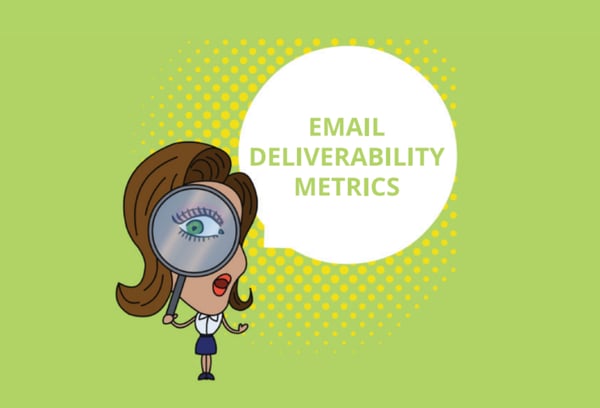
Open Rate
Open rate is the percentage of recipients who opened your email out of those were delivered your email.
ISPs, ESPs, and Email Services can cause deliverability issues if you have bad open rates. Inbox providers, such as Gmail or Outlook, keep track of when a recipient is opening emails. When you have a low open rate, a recipient’s inbox provider may penalize you by sending future emails into their spam or junk folder, which will cause lower open rates. The skinny on open rates:
- A 20% or higher open rate is your goal; HubSpot encourages you to get 25%+ (2,500 out of 10,000)
- A 15% to 19% rate can cause deliverability issues
- With a 10% to 14% rate, you'll encounter a lot of issues
- Below 10% and your mailing list, your content, or both need significant improvement
Bottom line, open rates are becoming fake news as the ISPs, ESPs, Corporate Servers and Email Services play games with us. Click-through rates are about the only thing you can trust for performance ROI. Read on.
Click-Through Rate
Click-through rate is the percentage of people who clicked a link in your email out of those who opened your email.
Click-through rate shows real email recipient engagement. If they clicked on your email, they were interested in it, even for only 2 seconds. A clicked email tells the ISPs, ESPs, and Email Services that yes, the recipient likes you for the moment.
Good click-through rates vary depending on industry and organization — even the content of the email you sent.
- A 7% and above click-through rate is a good goal depending upon your industry (17 5 clicks out of 2,500 opens)

Hard Bounce Rate
A hard bounce rate is the percentage of emails that couldn’t be delivered because the email address was invalid or no longer in use or your email was marked as spam by the recipient’s email server.
Inbox providers, such as Apple, Gmail, and Outlook, keep track of bounce rates. When you have a high bounce rate, a recipient’s inbox provider may penalize you by sending future emails into their spam or junk folder, which can then cause lower open rates. And the never-ending cycle goes on and on and on until your email list becomes essentially undeliverable.
We’ll ignore soft bounces. A soft bounce is a temporary deliverability issue instead of a hard bounce, a permanent deliverability problem. There are many causes for a soft bounce, some of which include: The recipient's inbox is full.
If you bounce a bunch of emails with one email send, HubSpot or MailChimp may suspend your email capability immediately. We call this delightful process “email jail.” And you’ll have to answer questions, fill out forms, and beg forgiveness to be let out of jail. You will still be on double-secret email probation, and they will be watching your next moves closely.
Bounces do happen, especially when warming up a send list. However,
- Below 0.3% hard bounce rate per send is a good goal (30 out of 10,000 sent)
Unsubscribe Rate
Unsubscribe rate is the percentage of people who unsubscribed out of those who were delivered your email.
We don’t track this as closely, and we sure don’t sweat it. Unsubscribes happen with every single email send. Unsubscribes are an argument for being careful with your frequency as you lose a certain percentage of your email contact list with every send. Eventually, your inbox providers may penalize you for having a high unsubscribe rate by sending future emails to the spam or junk folder.
Spam Report Rate
Spam report rate is the percentage of people who marked an email as spam out of those who were delivered your email. Not all inbox providers give information about when a contact marks an email as spam in their inbox. If you are getting reported as spam frequently, you are doing something wrong with your content or contact list and should evaluate your practices immediately.
- Below 0.1% spam rate is okay (10 spam out of 10,000 delivered)
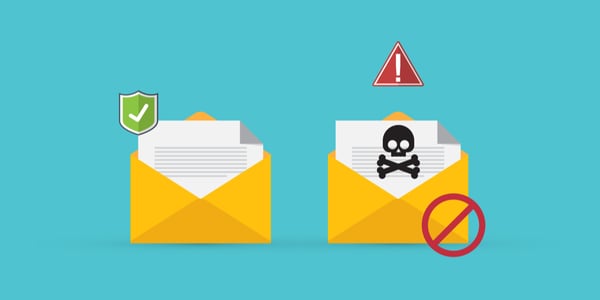
Technical Steps to Increase Overall Email Deliverability
Email Service Provider (ESP)
Only use a known ESP because their reputation is stellar, which means the sending IP will, in turn, increase your email deliverability. Our weapon of choice is HubSpot because it includes Marketing, Sales, CMS & Services tools all-in-one.
Sending Domain
Be careful with the reputation of your sending domain. And, if you are a SaaS company (software as a service), your sending domain may be wrapped up with your software domain. Any mistakes with marketing email could lead to deliverability problems for your employees and your software as it tries to send out SMTP email via your application.
Here are our suggestions based on dealing with a lot of software startups:
New Company
When your company is brand new, this likely won’t matter too much as everyone starts together, employees, software, and marketing alike. As long as everyone plays nice and pays attention, your domain’s reputation will remain clean.
Separate Email Sending Domain
Separate Email Sending Domain
Creating a separate sending email domain is not a terrible idea if you have an existing company with a lot tied up in your domain. For example, as mentioned, your software sends out a lot of reports and information to customers.
The plus of a separate email sending domain is that your corporate domain used by your software, website, and employees is protected from marketing email sends. The negative is that this new marketing email domain has no history and starts from scratch, building a reputation with the ISPs and the like. Over time, it will be okay, but the open rates and click-through rates will suck in the short run.
To .com or Not to .com?
We hate to sound old-fashioned and not very cool (we aren’t), but if you can create an email domain that uses the top-level domain (TLD) “.com” please do so. (We are assuming you are a regular “for-profit” company. Perfectly legit extensions of .edu and .org are a-okay as well in those worlds.) The “com” is derived from the word “commercial” and was originally intended for domains registered by commercial organizations. Here is why we suggest using .com for email if you can do it. Email is an ancient tool. The new domain extensions like .ai and .co sometimes are not as familiar to old-fashioned platforms and corporate email servers. They oddly might be blocked, and you would never know it. If you must use .ai or .co expect a longer warming up time for your email sending domain.
.energy or .tech?
We do have to draw the line at any of the new gTLD extensions. Please don’t have a domain extension like .example, .energy, .auto, .tech, etc. And, side tip, if you make this your employee's company email domain, you will quickly find out that hotel and airline reservation systems have issues. The common folk don't understand that your clever yourname@yourcompany.energy email address is a real email address. Just because you can, doesn’t mean you should.
In three to five years, go crazy. But for now, if you can stick with .com you’ll be saving yourself trouble that will never be quantifiable to you (in undelivered email and employee frustration).
.png?width=600&name=unnamed%20(2).png)
Contact List
Opt-In
Oh, if we had a dollar for every time a client tells us, "Our list is all opt-in contacts." Oh really. These 60,000 contacts have received an email from your domain before and have opted in to receive email from you?
They will stare at us blankly over Zoom, and with a straight face, blink once or twice and say, “Yes.”
We never believe them. Ever. Well, we did one or two times. But seriously, never again.
For the uninitiated, an opt-in list is a list of emails from people who willingly gave you their email address in some way, shape, or form: submitting email in exchange for downloadable content on your website, actively subscribing to your newsletter, visiting your trade show booth and badge swiping, or signing up for a webinar. All these people expect to receive emails from you.
An opt-in email list is not:
- A List you took from your previous company
- A list you bought on the internet
- A list you download from your LinkedIn contacts
Purchased Lists
We will not send marketing emails to a purchased list. Those days are long gone. We will, however, encourage our clients to talk to the source of the list — say their favorite industry publication — and ask if we can include an article in the source’s newsletter (for a fee, of course). If the article has a hardcore CTA (call to action), like give us your email for this cool white paper PDF, then included in a third-party newsletter, is a great way to collect valid and legal opt-in emails.
Emails Obtained Through ZoomInfo, Seamless.ai, et. al.
We will not send marketing emails to an email obtained through company research tools like ZoomInfo.com (rich man’s tool) or Seamless.ai (startup tool). However, we will encourage your sales team members to use these tools, find valid targeted contacts, and reach out to them directly using their company email. And, we encourage and train our sales team members to use automation to do it, like HubSpot’s Sales Templates and Sequences automation.
HubSpot Sequences are a series of sales emails and tasks designed for "one-to-one" communication. Ideally, a salesperson, BDR, or SDR doing outreach for any number of reasons uses sequences. We say it's 1-1 because the templates are personalized, and a good CRM like HubSpot will force sales team members to go through these emails one at a time and add that personalization, if possible while enrolling them.
A List With a Lot of Group Emails
If your list has a lot of group emails like info@ or sales@, remove them. ISPs want emails to be sent to people, not groups. And someone in the group (notoriously AR@ or AP@) will mark your email as spam.
Old Lists
Another type of list can be an opt-in list, but it is old (opt’d in over a year ago), and it hasn’t been emailed to recently (within the last couple of months or so). This list is dangerous to send email. Why? It is estimated that over 20% of all emails expire every year in B2B and even faster in certain economic climates. Therefore, an old list will have high bounce rates.
How to Ensure Deliverability of Your Contact List
If you feel your contact list is the right people, but it is an old list, or you don’t trust that the emails are 100% opt-in, it is always best to verify your list through a third-party tool like NeverBounce. We run an old opt-in list through NeverBounce, and we only send emails that NeverBounce marks as “Valid.”
Here are HubSpot’s exact rules to determine if it’s okay to send marketing emails to a contact list. They are strict, and they are consistent with any other ESP.
Email Sending Warm-Up
contacts that have been validated through a third-party tool. Hooty hoot!!! Let’s send an email!!!
Not so fast, cowboy. 🤠 You can’t just wake up one day and send 30,000 emails from a new domain and a new ESP and have anything good happen. Believe it or not, there are sending limits that the ISPs could invoke as well (damn, if it's not one thing, it’s another). If you have never sent 30,000 emails, don’t expect to do it on Black Friday. You have to work your way up to that.
We are highly cautious when sending emails, especially from a new sending domain and a new ESP (like HubSpot).
Here are our exact steps to warm up a sending domain with a new sending IP (from a new ESP):
- Sending domain DNS - Set up the sending domain properly using recommended ESP DNS records. For HubSpot, this includes DKIM records and an SPF record. Your ESP will tell you exactly what they need.
- Sending email box creation - Create a sending email box that can receive any reply emails to your sending email. We have been using hello@domain.com, where domain.com is your domain. This can’t be an alias email box. This is where all the “out of office” no replies will go. And occasionally, someone might reply, so check this email box. We connect it to HubSpot’s Conversations Inbox, which is an excellent way for team members to monitor one email address box.
- Opt-Out email list - If your team has used another ESP before, you have to download the opt-out list and upload it to the new ESP as an opt-out list.
- Batch up the new contact list - Break your new contact list into batches of 500 with batch numbers. These batch numbers can be set in excel as a new “field” in your CRM. Set this property up in your CRM.
- Upload your contact list to ESP - Upload your contact list with the batch number property to your ESP.
- Create your first email in your ESP - This will be a whole separate subject in this ebook about creating a good deliverable email. For your very first email, don’t shoot for heavy interaction. Ideally, pick a great blog post you feel your contact list would be interested in and have an excellent subject line. Make the email short, sweet, and professional. Below is one used recently that got crazy good results (20%+ open rate and 20%+ click-through rate). Considering the enormous number of emails sent and received every day, your emails can’t contain too much content or too many images. These days, people want to consume content quickly, which means your email templates need to be slim and to the point.
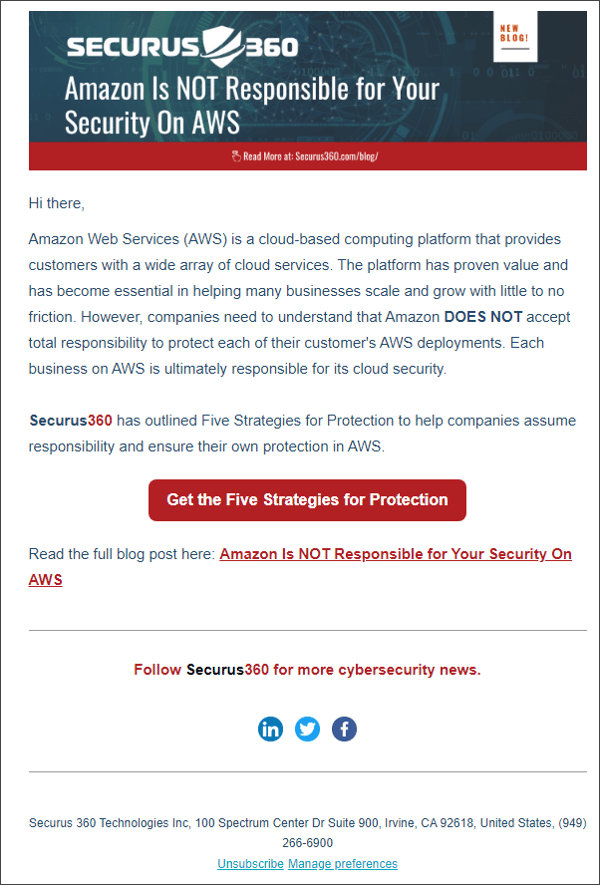
Excellent Domain and ESP Warmup Email from Securus360
- Send your first trial email to 100 contacts from your first batch of 500. Include in your first 100 contacts all of your friendlies — employees from the company, your vendors, their investors. In advance, warn these people of your first send.
- Ask these "friendlies" to reply to the email, add the email sending address to their safe-senders list, mark the email as "important," and, even better, forward it to their friends. These acts of email kindness from your supporters all send "good" signals to ISPs.
- If this email domain is also your company domain, it does help that your employees have been using it to conduct business, with replies coming in and emails being sent out steadily. You are again showing positive signs from your domain.
- Check the results of the first 100. If acceptable (bounces and unsubscribes are tolerable), schedule the remainder of the first batch of 500 to send the next business day.
- The next day check the results for the remainder of Batch 500. If okay, continue sending 500 a business day for 5 or so days. If you're feeling comfortable and brave, send up to 1,000 a day. Maybe after a week, send 2,000 a day. And so on for 2-3 weeks until the entire list has been sent.
- Database hygiene - As emails hard bounce and opt-out, mark them for removal from your database and get them off your active sending list. If this is the first time using a contact list and sales have not been engaging with these prospect companies, go ahead and delete bad emails right away.
- Metrics to expect - Even though you have validated these email addresses and are sending highly relevant content to the target audience, you can expect three things:
- High than average bounce rates (email validation systems are not perfect)
- High unsubscribe rates (can be perceived as cold email if the domain is new)
- A few Spam reports. One or two is not a big deal. 5+ is a bigger deal. 10+ is a huge deal.
- Your next “real” email - When you have another email to send, hopefully within a week of completing your email warm-up, break your next email into sending batches of 5,000 to 10,000, depending on the list size. Ease into sending to the entire list. Yes, this takes time and is manual, but your efforts will pay off in the long run.
- From there on out - In B2B, try to send an email at least weekly, let the ISPs know you are communicating regularly, and hopefully engage your prospects with your excellent content. Two times a week can be okay when you have special news, like a press release or an invitation to a webinar plus your regular newsletter, but any more than that, and you are playing with fire. Remember, contacts are unsubscribing as rapidly as you are sending. It is a fine line.
.png?width=600&name=unnamed%20(3).png)
Back to Top
Best Practices for Creating a Highly Deliverable Email
At this point, you can Google for millions (literally) of articles on creating emails that deliver. The following are our best practices that we have culled through time, research, and a great deal of experimentation.
Email Subject Line
- Shorter is better, especially for those reading emails on mobile devices. Some recommend you use no more than nine (9) words and 60 characters. Other articles suggest under 44 characters. You get it. Short.
- Make your subject line catchy, using high-interest words to prospect.
- Avoid all CAPS
- Limit punctuation but don’t be afraid to use exclamation marks
- Limit special characters like * % & and ^
- Avoid spam word triggers like FREE, ORDER, EARN $, MONEY -- you get it.
- Do not use a misleading subject line, like: “Did I leave my jacket at your place?” or “re: our last conversation” and other weird, annoying tactics.
Email Length
- Welp, it depends on the email - in general your email templates need to be SLIM and TO THE POINT (yelling)
- Focus on one topic and one goal per email.
- Make sure the email is only two screen lengths of scrolling
- Sales email - Between 50 and 125 words has the highest response rate of 50%. A similar study found emails with approximately 20 lines of text, or about 200 words, had the highest click-through rates. When in doubt, keep emails short and under 200 words.
- Marketing email - 50 to 200 words. But they say the ideal length is not a hard and fast rule depending on the value of the content
.png?width=600&name=unnamed%20(4).png)
Snippet of the ReviewPoint email Newsletter. There are several more stories following
picture/copy, picture/copy format.
Images
- Ratio Image to Text - As a general guideline, we recommend a ratio of 80% text to 20% images in an email. However, all spam filters use different criteria for what is a healthy balance of graphics and text.
- Image Size - The best image size for email is still 600px to 650px wide. We generally use 600px. However, you can play around with the length.
- Do not use one large image for your entire email.
- Use relevant, and interesting ALT text in case subscribers have the image download disabled.
- Watch out for images with tiny text. They just won’t display on mobile correctly.
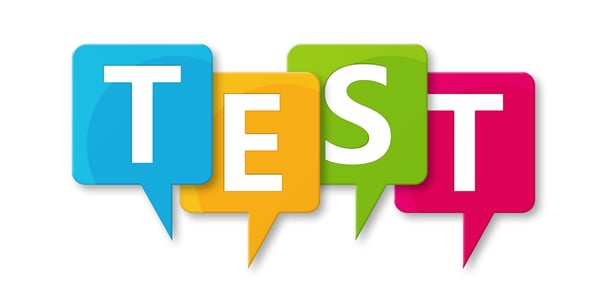
Test on Different Browsers
Test your email on different browsers, in other email clients, and on various screen sizes. HubSpot includes a Litmus integration out of the box, which allows you to do just that.
Personalization
If you can include any dynamic content personalization in your marketing, the email will achieve better results. Even a “Hello First_Name” is better than nothing.
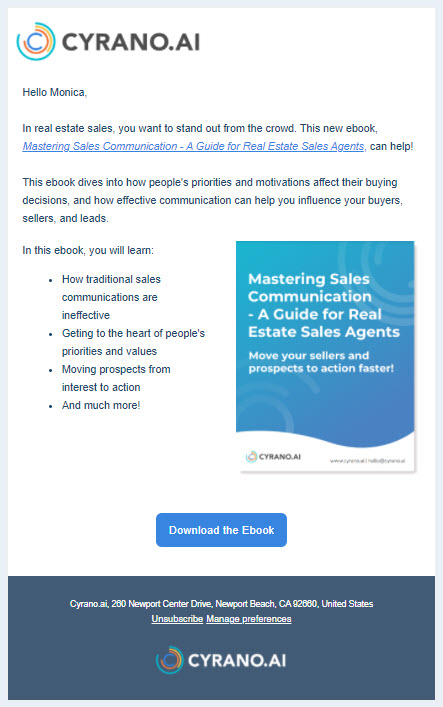
Nice short and sweet email from Cyrano.ai.
Animated Gifs
In B2B, we don’t use them at all. We have seen discussions that say they increase opens/clicks and discussions that say they detract. Be careful, professional, and appropriate.
Frequency
We like 1x a week at a minimum in the B2B space with relevant and appropriate content.We will take this up to 2x when there is a special message like a press release, a webinar invite, a trade show booth announcement. But honestly, that is about it. Your prospects unsubscribe every single time you send, so use your email tool judiciously.
Grammar and Spelling
For the love of all that is holy, please slap your email copy into Grammarly and check it for spelling and grammar errors.
Address and Unsubscribe
Any legit ESP will force you to have your physical address and unsubscribe links in the email footer.
You should have a prominent privacy policy in your website footer.
Test Subject Line
- Consider A/B testing your subject line, your header image and or your content. Tools like HubSpot make this incredibly easy.
- B2B caveat - Look, don’t make us give you our favorite statistics lecture. When dealing with a new B2B with, say, a list of 759 emails (no lie, it happens all the time), testing gives you non-statistically valid results. You can get directional but not statistically significant answers to your questions. It is not worth the time in most cases. You have to make your best guesses based on experience and prior results taken from other businesses and marketing experiences.
.png?width=400&name=unnamed%20(5).png)
Grasp Technologies’ Email Newsletter in HubSpot Mobile Render.
.png?width=400&name=unnamed%20(6).png)
An excellent example of email from the experts at Litmus
Contact List Hygiene
Why Remove Perfectly Good Emails?
Remember, at the beginning of this ebook, we discussed graymail. Here is where it comes into play. Contact list hygiene, purging your list of good emails who don’t engage, is a relatively new subject, necessitated by the increasingly punitive ISPs and ESPs. It is best to cull your email list before your sending reputation gets damaged. Email hygiene is an ever-evolving topic, and it is somewhat art and not science at this point.
It is kind of black magic behind the scenes at the ISPs and ESPs. They don’t tell you the rules. They just quietly punish you. Suffice it to say, if you see your emails stop delivering reasonable open rates or click-through rates, and you feel your list is correct, and your emails are excellent, it may be that, for some reason, your ISP or ESP has ceased delivering to your email list.
Says HubSpot, “Without taking action, low open rates of your marketing emails can often worsen over time. Email service providers like Gmail or Outlook will move emails with low engagement to the spam folder, which can lead to open rates dropping further since fewer users will see your emails once they're filtered out of their inbox.”
How to Purge Lists of “Unengaged” Contacts
Here is what we recommend and what we have implemented across our client base. It comes from this article on contact list clean-up from HubSpot. Essentially you have to segment your email list and clean out people who are not interacting with your email.
- Temporarily suppress contacts who have received 10+ emails and never opened them or may have previously opened a marketing email from you but haven’t opened the last ten (10) emails you have sent
- Stick the temporary suppressions in a pile by themselves and send to them quarterly with a unique “open me” type of email or offer.
- Before sending to these colds, revalidate them using NeverBounce
- Create a sunset policy to manage these disengaged contacts
- Consider a re-subscription campaign (last chance)
- Permanently suppress contacts (non-marketing in HubSpot) who have hard-bounced and unsubscribed. Suppression will happen automatically in most ESPs, but it is good for you to move them away from your active marketing campaigns so you will stop attempting to send to them.
.png?width=700&name=unnamed%20(1).png)
Let's Wrap It Up!
Let’s Wrap It Up!
A lot to think about, right? We don’t deny that email marketing has gotten a little cray-cray. Over the years, things have changed. But, B2B email remains a relevant and essential channel in your marketing strategy execution. The ISPs and ESPs have become sophisticated, working on the email receivers’ behalf and going above and beyond to block emails they deem to be spam. Yes, Apple, Google, and Microsoft are all conspiring against your business. What else is new?
The trick is, how do you avoid becoming the recipient of this unwanted attention?
It’s straightforward (8 steps):
- Pick a popular ESP.
- Setup both your sending domain and sending email address perfectly.
- Understand the email metrics that matter in this game (primarily open rate and click-through rate).
- Be selective and picky about where you get your email lists; don’t engage in unscrupulous practices; you’ll get caught and punished.
- Make sure you clean contacts before you begin sending email to a new list.
- Engage in best practices ESP IP and sending domain warm-up procedures.
- Create top-notch, highly engaging, quality emails.
- Implement ongoing automated contact list hygiene.
Now go win the inbox.

Resources
We have linked the HECK out of this ebook to our sources. Click and explore any topic in depth. HubSpot’s Email Marketing Course has invaluable information and a ton of links to additional resources as well.
Source Attribution
And if you happen to be one of the sources for this ebook, THANK YOU. If you have changes to your attribution, please send us a note.
Read More About Email
- How to Create and Warmup a Marketing Email Sending Domain
- HubSpot Customers: How To Fix Your DNS Records To Comply With Google Yahoo 2024 Email Policy Changes
- Remove Group Emails From B2B Email Campaigns
- 📧 Preparing For 2024: Essential Google & Yahoo Email Tips For HubSpot Marketers
- GURU 2023 Recap 👀 Jay Schwedelson's Online Email Marketing Conference
- 📧 Email Mentor Serves Up 🔥 Quick Tips In New HubSpot Webinar
- HubSpot Article: Overview of email authentication
- 📧 7 Email Tricks - How To Get Your Prospects To Take Action!
- 🚀 Orange Marketing's Best Performing Email Of All Time
- 🙄 Snarketing Alert: Stupid Automated Sales Emails
- 📧 How To Improve Your B2B Email Marketing ROI






